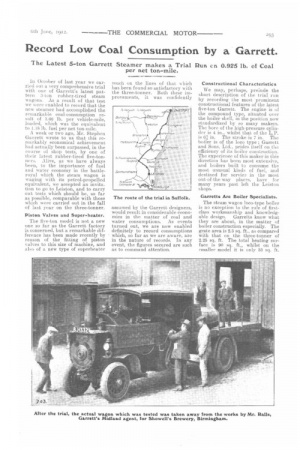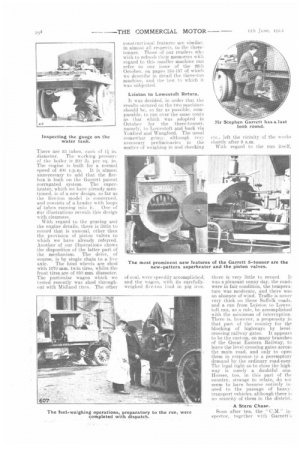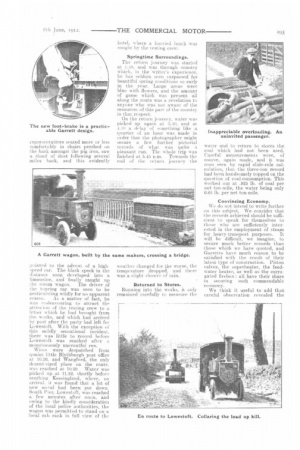Record Low Coal Consumption by a Garrett.
Page 17

Page 18

Page 19

Page 20

If you've noticed an error in this article please click here to report it so we can fix it.
The Latest 5-ton Garrett Steamer makes a Trial Run cn 0.925 lb. of Coal per net ton-mile.
In October of last year we carried out a very comprehensive trial with one of Ga.rrett's latest pattern 3-ton rubber-tired steam wagons. As a result of that test we were enabled to record that the new steamer had accomplished the remarkable coal-consumption result of 3.86 lb. per vehicle-mile, loaded, which was the equivalent to 1.18 lb. fuel per net ton-mile.
A week or two ago, Mr. Stephen Garrett. wrote to us that this remarkably economical achievement. had actually been surpassed, in the course of shop tests, by one of their latest rubber-tired five-tonners, Alive, as we have always been, to the importance of fuel and water economy in the battleroyal which the steam wagon is waging with its petrol-propelled equivalent, we accepted an invita_ tion to go to Leiston, and to carry out tests which should be, so far as possible, comparable with those which were carried out in the fall of last year on the three-tonner.
Piston Valves and Super-heater.
The five-ton model is not a new one so far as the Garrett factory is concerned, but a remarkable difference has been made recently by reason of the fitting of piston valves to this size of machine, and also of a new type of superheater much on the lines of that which has been found so satisfactory with the three-tonner. Both these improvements, it was confidently assumed by the Garrett designers, would result in considerable economies in the matter of coal and water consumptions. As events turned out, we are now enabled definitely to record consumptions which, so far as we are aware, are in the nature of records. In any event, the figures secured are such as to command attention, ,Constructional Characteristics
We may, perhaps, prelude the short description of the. trial run by recording the most prominent constructional features of the latest five-ton Garrett. The engine is of the compound type, situated over the boiler shell, in the position now standardized by so many makers. The bore of the high-pressure cylinder is 4 in., whilst that of the L.P. is 61 in. The stroke•is 7 in. The boiler is of the loco type ; Garrett and Sons, Ltd., prides itself on the efficiency of its boiler construction. The experience Of this maker in this direction has been most extensive, and boilers built to consume the most unusual kinds of fuel, and destined for service in the most out-of-the-way places, have for many years past left, the Leiston shops.
Garretts Are Boiler Specialists.
The steam wagon loco-type boiler is no exception to the rule of firstclass workmanship and knowledgable design. Garretts know what they are about, in the matter of boiler construction especially. The grate area is 2.5 sq. ft., as compared with that on the threc-tonner of 2.25 sq. ft. The total heating surface is 90 sq. ft., whilst on the saintlier model it is only 53 sq. ft. There are 53 tubes, each of 11 in.
diameter. The working pressure of the boiler is 200 lb. per sq. in. The engine is built for a normal
speed of 400 r.p.m. It is almost unnecessary to add that the firebox is built on the Garrett patent corrugated system. The superheater, which we have already mentioned, is of a new design, so far as the five-ton model is concerned, and consists of a header with loops
of tubes running into it. One of our illustrations reveals this design with clearness.
With regard to the gearing and the engine details, there is little to record that is unusual, other than the provision of piston valves to which we have already. referred. Another of our illustrations shows the disposition of the latter part of the mechanism. The drive, of course, is by single chain to a live axle. The hind wheels are shod with 1070 mm. twin tires, whilst the front tires are of 850 mm. diameter. The particular wagon which we tested recently was shod throughout with Midland tires. The other constructional features are similar. in almost all respects, to the threetonner. Those of our readers who wish to refresh hcir memories with regard to this smaller machine can refer to our issue of the 26th October, on pages 154-157 of which we describe in detail the three-ton machine, and the test to which it was subjected.
Leiston to Lowestoft Return.
Ii was decided, in order that the results secured on the two machines should he, so far as possible. comparable. to run over the same route as that which was adopted in October for the three-tonner, (lamely, to Lowestoft and back via Yoxford and NSTangford. The usual somewhat grimy, although very necessary preliminaries in the matter of weighing hi and checking of coal, were speedily accomplished, and the wagon, with its carefullyweighed five-ton load in pig iron.
etc., left the vicinity of the works shortly after 9 a.m.
With regard to the run itself, there is very little to record. It
was a pleasant sunny day, the roads were in fair condition, the temperature was moderate, and there was an absence of wind. Traffic is never very thick on these Suffolk roads. and a run from Leiston to Lowestoft can, as a rule, be accomplished with the minimum of interruption. There is, however, a propensity in that part of the country for the blocking of highways by levelcrossing railway gates. It appears to be the custom, on many branches of the Great Eastern Railway, to leave the level-crossing gates across the main road, and only to open them in response to a peremptory demand by the ordinary road-user. The legal right so to close the highway is surely a doubtful one. Horses, too, in this part of the country, strange to relate, do not seem to have become entirely inured to the passage of heavytransport vehicles, although there is no scarcity of them in the district.
A Stern Chase.
Soon after ten, the " C.31." inspector, together with Garrett's
representatives seated more or less comfortably in chairs IL-perched on the back amongst the pig iron, saw a, cloud of dust following several miles back, and this evidently
pointed to the advent of a highspeed ear. The black speck in the distance soon developed into a iimousine, and finally caught up thie steam wagon. The driver of the touring car was seen to be gesticulating wildly for no apparent reason. Ss a matter of fact, he was endeavouring to attract the atteni iii of the testing crew to a letter which he had brought from the works, and which had arrived by post after the party had left for Lowestoft. With the exception of this mildly sensational incident, there was little to record before Lowestoft was reached after a monotonously uneventful run. Wires were despatched from quaint little Blythburgh post office at 10.26. and Wangford, the only decent-sized place on the route. was reached at 10.50 Water was picked up at 11.22. shortly before reaching Kessingland, where, on arrival, it was found that a lot of new metal had been put down. South Pier, Lowestoft, was reached a few minutes after noon, and owing to the kindly consideration of the local police authorities, the. wagon was permitted to stand on a local cab rank in full view of the hotel, where a harried lunch was sought 1-py the testing crew.
Springtime Surroundin gs.
The return journey was started at L18, and was through country which, in the writer's experience, he has seldom seen surpassed for beautiful spring conditions so early in the year. Large areas were blue with flowers, and the amount of game which was present. all along the route was a revelation to anyone who was not aware of the resources of this part of the country in that respect.
On the return journey, water was picked up again at 3.40, and at 4.10 a, delay of something like a quarter of an hour was made in order that the photographer might secure a few further pictorial records of what was quite a pleasant run. The whole trip was finished at 5.45 p.m. Towards the end of the return journey the weather changed for the worse, the temperature dropped, and there was a slight shower of rain.
Returned to Stores. Running into the works, it only remained carefully to measure the water and to return to stores the coal which had not been used. Careful measurements were, of course, again made, and it was soon seen by rapid slide-rule calcula.tion, that the three-ton record had been handsomely topped on the question of coal-consumption. This worked out at .925 lb. of coal per net ton-mile, the water being only 6.64 lb. per net ton-mile.
Convincing Economy.
We do not intend to write further on this subject. We consider that the records achieved should be sufficient to speak for themselves to those who are sufficiently interested in the employment of steam for heavy-transport purposes. It will be difficult, we imagine, to secure much better records than those which we have quoted, and clarretts have much reason to be satisfied with the result of their latest type of construction. Piston valves, the superheater, the feedwater heater, as well as the corrugated firebox : all have their share in securing such commendable economy.
We think it useful to add that careful observation revealed the fact that, this latest five-tonner is remarkable for the ease with which it can be handled. The control details are carefully located, the brakes are efficient and their easy operation is convenient, the boiler is free-steaming and responds satisfactorily to the care of a skilful fireman. A word should also be added with regard to the ease of steering of this heavy machine. During the trial, the phenomenon of electrical charging of the rubber-mounted steamer was noticeable to a marked degree.
Superheated-steam.
This latest Garrett wagon should appeal to all those Who, while able to use steam, have to keep a very sharp eye on the matter of fuel expenses. The workmanship and material are of such a quality that maintenance charges are low. That what we say in this respect is correct may be verified by anybody sufficiently interested to go down to the Leiston works. and there to examine the great variety of steam plant which is constantly going through the shops. Garrett and Sons. Ltd., has an enviable reputation for hospitality. and visitors who are genuinely interested in this company's productions are welcomed at Leiston with a view to the careful and thorough investigation of the methods of production and of the material put into the machines which leave the works.
We append the results of the trial of the five-tormer in tabular form.


























